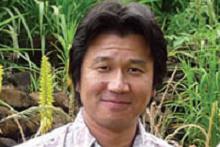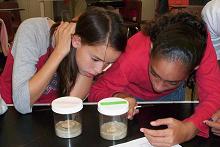
Issue 10 | July 05, 2011 | Archive
News & Events
Who Needs Dirt?
 A workshop on the “Challenges and Opportunities of Soil-Less Farming in Hawaii,” facilitated by Clyde Tamaru (MBBE, pictured), will be offered on Saturday, July 23, at Windward Community College from 9:00 to 12:30. Participants can find out about food safety certification of aquaponically and hydroponically grown foods from Jim Hollyer (PEPS) and discuss the economic realities of these farming methods with Harry Ako (MBBE). Then participants will hear from farmers already successful in this field, including Richard Ha of Hamakua Springs Country Farms and Paul Singleton of Waipoli Hydroponic Greens. Finally, they’ll have the opportunity to talk with those who market produce in the Islands, including Tisha Uyehara of Armstrong Produce and James Channels of Foodland, to find out what is expected of growers. A limited number of seats are available—to reserve a place, please contact Harry Ako at 956-2012 or hako@hawaii.edu, or Clyde Tamaru at 342-1063 or ctamaru@hawaii.edu. Check here for more detailed information, including a program of the workshop and directions to WCC.
A workshop on the “Challenges and Opportunities of Soil-Less Farming in Hawaii,” facilitated by Clyde Tamaru (MBBE, pictured), will be offered on Saturday, July 23, at Windward Community College from 9:00 to 12:30. Participants can find out about food safety certification of aquaponically and hydroponically grown foods from Jim Hollyer (PEPS) and discuss the economic realities of these farming methods with Harry Ako (MBBE). Then participants will hear from farmers already successful in this field, including Richard Ha of Hamakua Springs Country Farms and Paul Singleton of Waipoli Hydroponic Greens. Finally, they’ll have the opportunity to talk with those who market produce in the Islands, including Tisha Uyehara of Armstrong Produce and James Channels of Foodland, to find out what is expected of growers. A limited number of seats are available—to reserve a place, please contact Harry Ako at 956-2012 or hako@hawaii.edu, or Clyde Tamaru at 342-1063 or ctamaru@hawaii.edu. Check here for more detailed information, including a program of the workshop and directions to WCC.
Governor's Garden
 CTAHR partnered with individuals, schools, community associations, and the Hawaii Department of Agriculture to establish a “new day” vegetable and fruit garden at the governor’s residence on the Washington Place grounds. The garden will provide food for the first family and help to educate the community about fresh, nutritious, locally grown vegetables and fruits, as part of a wider initiative to achieve a higher level of food security and self-sufficiency in the state. At the dedication and blessing ceremony, Kahu Kamaki Kanehele called the event “a truly new day in Hawai‘i.” He explained that this was the first planting of a vegetable garden at Washington Place since 1917, when Queen Lili‘uokalani lived there. About 20 children from the Kainalu Elementary School, the Nanakuli Elementary School, and the University Laboratory School, along with Governor Abercrombie himself, planted vegetable seedlings and fruit trees, among them papaya seedlings provided by CTAHR’s Ted Radovich (TPSS) and his sustainable agriculture program.
CTAHR partnered with individuals, schools, community associations, and the Hawaii Department of Agriculture to establish a “new day” vegetable and fruit garden at the governor’s residence on the Washington Place grounds. The garden will provide food for the first family and help to educate the community about fresh, nutritious, locally grown vegetables and fruits, as part of a wider initiative to achieve a higher level of food security and self-sufficiency in the state. At the dedication and blessing ceremony, Kahu Kamaki Kanehele called the event “a truly new day in Hawai‘i.” He explained that this was the first planting of a vegetable garden at Washington Place since 1917, when Queen Lili‘uokalani lived there. About 20 children from the Kainalu Elementary School, the Nanakuli Elementary School, and the University Laboratory School, along with Governor Abercrombie himself, planted vegetable seedlings and fruit trees, among them papaya seedlings provided by CTAHR’s Ted Radovich (TPSS) and his sustainable agriculture program.
Grants & Awards
Weed Eaters and Papaya Pests
Three project teams led by CTAHR faculty were awarded nearly $500,000 by the USDA Western Sustainable Agriculture Research and Extension (WSARE) program. Since 1988, SARE has funded more than 69 projects in Hawai‘i, with total grants exceeding $3 million for farmers, ranchers, Extension agents and educators, researchers, nonprofits, students, and communities. Check here for a complete list of Hawai‘i awardees.
- “Training Livestock to Eat Weeds in the Tropical Pacific and Evaluating the Effects on Meat Quality for Stronger Ranch Profits,” Principal Investigator: Matthew Stevenson (HNFAS); producer cooperator: Randall Cremer; $49,610.
- “Reducing Pacific Island Growers’ Reliance on Off-Island Fertilizer Sources through Improved Awareness and Efficient Use of Local Inputs,” Principal Investigator: Theodore Radovich (TPSS); cooperators: Nguyen Hue (TPSS), Jari Sugano (PEPS), Mark Hamamoto, Al Santoro, Tova Callender, Stanley Gurr, Fred Takebayashi, Alton Arakaki (TPSS), Mark Cummings, Hector Valenzuela (TPSS), Linda Cox (NREM), Leland Nishek, Kimo Franklin; $284,070.
- “Developing Sustainable Pest Control Practices Against Major Pests in Papaya in Hawaii,” Principal Investigator: Leyla Kaufman (PEPS); cooperators: Melvin Matsuda, Kenneth Kamiya, Ross Sibucao, Orlando Manuel, Mark Wright (PEPS), Koon-Hui Wang (PEPS), Jari Sugano (PEPS); $148,174
An Eye on the Environment
 Tomoaki Miura (NREM, pictured) has been awarded a 3-year research grant from NASA with a total funding of over $600,000. He'll be working as a science team member for one of the two primary sensors of the next-generation United States environmental monitoring satellite system, the Visible Infrared Imaging Radiometer Suite (VIIRS) sensor. The VIIRS collects information on land and sea surface temperatures, clouds, polar ice, and other indicators that are used to get a better understanding of global climate change. This is a new and exciting research territory for CTAHR, and Tomoaki is just the person to lead the college into it.
Tomoaki Miura (NREM, pictured) has been awarded a 3-year research grant from NASA with a total funding of over $600,000. He'll be working as a science team member for one of the two primary sensors of the next-generation United States environmental monitoring satellite system, the Visible Infrared Imaging Radiometer Suite (VIIRS) sensor. The VIIRS collects information on land and sea surface temperatures, clouds, polar ice, and other indicators that are used to get a better understanding of global climate change. This is a new and exciting research territory for CTAHR, and Tomoaki is just the person to lead the college into it.
Spotlight on Our Community
Teaching With Termites
 For the past 8 years, CTAHR has been partnering with Hawai‘i public school teachers on the “Termite Project - Educate to Eradicate” curriculum program to teach kids science using those mighty munchers, Formosan subterranean termites. The curriculum project, led by Interim Associate Dean Ken Grace and PEPS Extension Specialist Julian Yates and funded by USDA-ARS, started with 90 students in four O‘ahu classrooms in 2003. Since then, it's reached over 10,000 students in 370+ classrooms statewide. The program has garnered regional and even national attention. Last month, 1st grade teacher Cory Shindo of Kipapa Elementary and biology teacher Tanya Ashimine of Kaiser High School were each awarded the 2011 President’s Prize in Primary and Secondary Education by the Pacific Branch of the Entomological Society of America. Cory and Tanya have also been nominated for the society’s national awards, to be announced later this year. The program has also included a popular series of summer adult seminars on termite prevention, attended by over 2,000 Hawai‘i residents. The federal government has eliminated funding for the popular program this year, but Ken and Julian, along with project director Maria Aihara-Sasaki (PEPS) and entomology graduate student Makena Mason, have been focusing on making it a sustainable, teacher-driven program for the past several years. CTAHR plans to continue providing curriculum tools (and termites!) to partner schools for as long as possible to boost science literacy and help achieve the goal of termite-free Hawai‘i houses.
For the past 8 years, CTAHR has been partnering with Hawai‘i public school teachers on the “Termite Project - Educate to Eradicate” curriculum program to teach kids science using those mighty munchers, Formosan subterranean termites. The curriculum project, led by Interim Associate Dean Ken Grace and PEPS Extension Specialist Julian Yates and funded by USDA-ARS, started with 90 students in four O‘ahu classrooms in 2003. Since then, it's reached over 10,000 students in 370+ classrooms statewide. The program has garnered regional and even national attention. Last month, 1st grade teacher Cory Shindo of Kipapa Elementary and biology teacher Tanya Ashimine of Kaiser High School were each awarded the 2011 President’s Prize in Primary and Secondary Education by the Pacific Branch of the Entomological Society of America. Cory and Tanya have also been nominated for the society’s national awards, to be announced later this year. The program has also included a popular series of summer adult seminars on termite prevention, attended by over 2,000 Hawai‘i residents. The federal government has eliminated funding for the popular program this year, but Ken and Julian, along with project director Maria Aihara-Sasaki (PEPS) and entomology graduate student Makena Mason, have been focusing on making it a sustainable, teacher-driven program for the past several years. CTAHR plans to continue providing curriculum tools (and termites!) to partner schools for as long as possible to boost science literacy and help achieve the goal of termite-free Hawai‘i houses.
Win-Win
 The members of the Kona 4-H Federation wanted to give back to their community, so they did. To the tune of thousands of dollars. The youth, with their adult partners, came together, brainstormed, and decided that in these tough economic times cold, hard cash was the way to go. They eventually raised more than $12,000 to benefit local and national charities, including the Ronald McDonald House, the Food Basket, the Japan-Hawaii Relief Fund, and the American Red Cross Hats Off Project. The charities were thrilled with the material support, but the 4-H’ers gained something more: hands-on experience in life skills such as communication, public speaking, decision making, empathy, working together, and taking responsibility.
The members of the Kona 4-H Federation wanted to give back to their community, so they did. To the tune of thousands of dollars. The youth, with their adult partners, came together, brainstormed, and decided that in these tough economic times cold, hard cash was the way to go. They eventually raised more than $12,000 to benefit local and national charities, including the Ronald McDonald House, the Food Basket, the Japan-Hawaii Relief Fund, and the American Red Cross Hats Off Project. The charities were thrilled with the material support, but the 4-H’ers gained something more: hands-on experience in life skills such as communication, public speaking, decision making, empathy, working together, and taking responsibility.
Got Milk?
 Corilee Watters (HNFAS) and her research assistants Lee Rosner (left) and Shelley Wong (right) are working with neonatologists, including Sheree Kuo (2nd from left) and Lynn Iwamoto (2nd from right) at Kapi‘olani Medical Center for Women and Children to investigate optimal nutrition for premature infants during growth and development. Both Lee and Shelley are recipients of Undergraduate Research Opportunities Council funding to complete studies on nutrition, growth and development. Lee’s project relates to growth outcomes as relating to early nutrition intervention, and Shelley’s project is on the effects of increased maternal breast milk administration to premature infants.
Corilee Watters (HNFAS) and her research assistants Lee Rosner (left) and Shelley Wong (right) are working with neonatologists, including Sheree Kuo (2nd from left) and Lynn Iwamoto (2nd from right) at Kapi‘olani Medical Center for Women and Children to investigate optimal nutrition for premature infants during growth and development. Both Lee and Shelley are recipients of Undergraduate Research Opportunities Council funding to complete studies on nutrition, growth and development. Lee’s project relates to growth outcomes as relating to early nutrition intervention, and Shelley’s project is on the effects of increased maternal breast milk administration to premature infants.